gas type JEEP WRANGLER UNLIMITED 2020 Owner handbook (in English)
[x] Cancel search | Manufacturer: JEEP, Model Year: 2020, Model line: WRANGLER UNLIMITED, Model: JEEP WRANGLER UNLIMITED 2020Pages: 330, PDF Size: 9.16 MB
Page 9 of 330
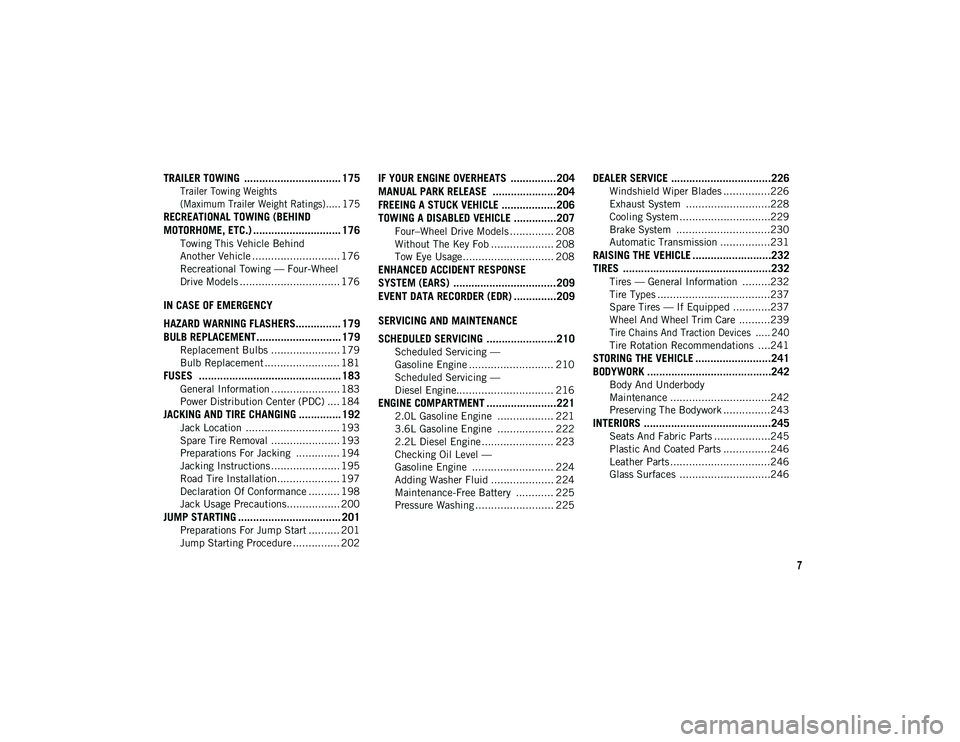
7
TRAILER TOWING ................................ 175
Trailer Towing Weights
(Maximum Trailer Weight Ratings)..... 175
RECREATIONAL TOWING (BEHIND
MOTORHOME, ETC.) ............................. 176
Towing This Vehicle Behind
Another Vehicle ............................ 176 Recreational Towing — Four-Wheel
Drive Models ................................ 176
IN CASE OF EMERGENCY
HAZARD WARNING FLASHERS............... 179
BULB REPLACEMENT............................ 179
Replacement Bulbs ...................... 179
Bulb Replacement ........................ 181
FUSES ............................................... 183
General Information ...................... 183
Power Distribution Center (PDC) .... 184
JACKING AND TIRE CHANGING .............. 192
Jack Location .............................. 193
Spare Tire Removal ...................... 193
Preparations For Jacking .............. 194
Jacking Instructions ...................... 195
Road Tire Installation.................... 197
Declaration Of Conformance .......... 198
Jack Usage Precautions................. 200
JUMP STARTING .................................. 201
Preparations For Jump Start .......... 201
Jump Starting Procedure ............... 202
IF YOUR ENGINE OVERHEATS ...............204
MANUAL PARK RELEASE .....................204
FREEING A STUCK VEHICLE ..................206
TOWING A DISABLED VEHICLE ..............207
Four–Wheel Drive Models .............. 208
Without The Key Fob .................... 208
Tow Eye Usage............................. 208
ENHANCED ACCIDENT RESPONSE
SYSTEM (EARS) ..................................209
EVENT DATA RECORDER (EDR) ..............209
SERVICING AND MAINTENANCE
SCHEDULED SERVICING .......................210
Scheduled Servicing —
Gasoline Engine ........................... 210 Scheduled Servicing —
Diesel Engine............................... 216
ENGINE COMPARTMENT .......................221
2.0L Gasoline Engine .................. 221
3.6L Gasoline Engine .................. 222
2.2L Diesel Engine ....................... 223
Checking Oil Level —
Gasoline Engine .......................... 224 Adding Washer Fluid .................... 224
Maintenance-Free Battery ............ 225
Pressure Washing ......................... 225
DEALER SERVICE .................................226
Windshield Wiper Blades ...............226
Exhaust System ...........................228
Cooling System .............................229
Brake System ..............................230
Automatic Transmission ................231
RAISING THE VEHICLE ..........................232 TIRES .................................................232
Tires — General Information .........232
Tire Types ....................................237
Spare Tires — If Equipped ............237
Wheel And Wheel Trim Care ..........239
Tire Chains And Traction Devices ..... 240
Tire Rotation Recommendations ....241
STORING THE VEHICLE .........................241
BODYWORK .........................................242
Body And Underbody
Maintenance ................................242 Preserving The Bodywork ...............243
INTERIORS ..........................................245
Seats And Fabric Parts ..................245
Plastic And Coated Parts ...............246
Leather Parts ................................246
Glass Surfaces .............................246
2020_JEEP_JL_WRANGLER_UG_RHD_UK.book Page 7
Page 109 of 330
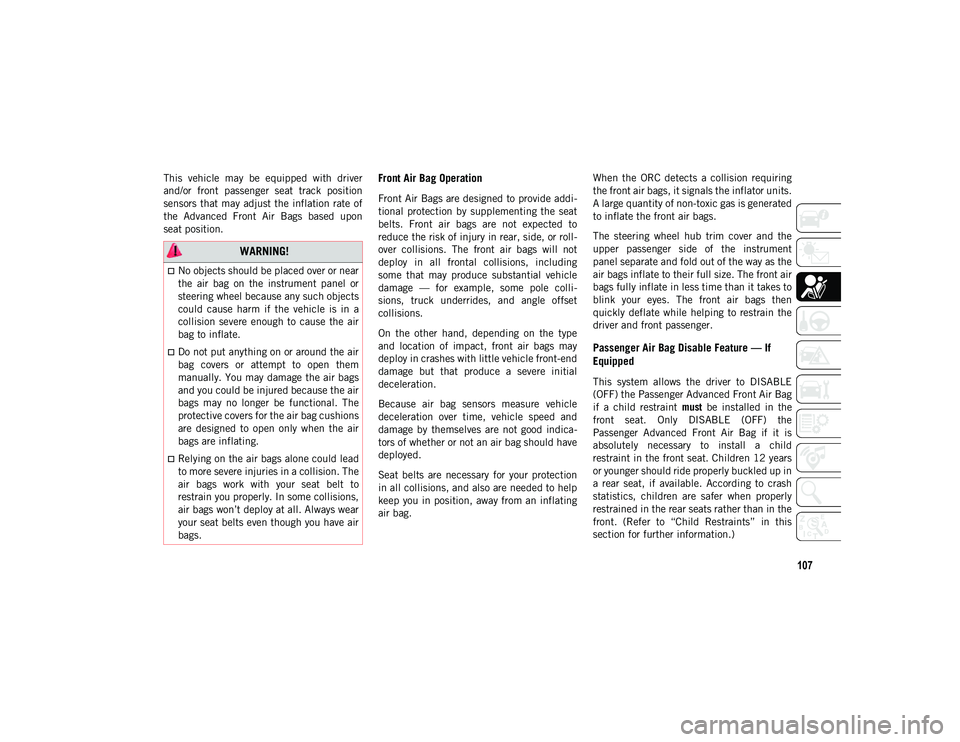
107
This vehicle may be equipped with driver
and/or front passenger seat track position
sensors that may adjust the inflation rate of
the Advanced Front Air Bags based upon
seat position.Front Air Bag Operation
Front Air Bags are designed to provide addi-
tional protection by supplementing the seat
belts. Front air bags are not expected to
reduce the risk of injury in rear, side, or roll -
over collisions. The front air bags will not
deploy in all frontal collisions, including
some that may produce substantial vehicle
damage — for example, some pole colli -
sions, truck underrides, and angle offset
collisions.
On the other hand, depending on the type
and location of impact, front air bags may
deploy in crashes with little vehicle front-end
damage but that produce a severe initial
deceleration.
Because air bag sensors measure vehicle
deceleration over time, vehicle speed and
damage by themselves are not good indica -
tors of whether or not an air bag should have
deployed.
Seat belts are necessary for your protection
in all collisions, and also are needed to help
keep you in position, away from an inflating
air bag. When the ORC detects a collision requiring
the front air bags, it signals the inflator units.
A large quantity of non-toxic gas is generated
to inflate the front air bags.
The steering wheel hub trim cover and the
upper passenger side of the instrument
panel separate and fold out of the way as the
air bags inflate to their full size. The front air
bags fully inflate in less time than it takes to
blink your eyes. The front air bags then
quickly deflate while helping to restrain the
driver and front passenger.
Passenger Air Bag Disable Feature — If
Equipped
This system allows the driver to DISABLE
(OFF) the Passenger Advanced Front Air Bag
if a child restraint
must be installed in the
front seat. Only DISABLE (OFF) the
Passenger Advanced Front Air Bag if it is
absolutely necessary to install a child
restraint in the front seat. Children 12 years
or younger should ride properly buckled up in
a rear seat, if available. According to crash
statistics, children are safer when properly
restrained in the rear seats rather than in the
front. (Refer to “Child Restraints” in this
section for further information.)
WARNING!
No objects should be placed over or near
the air bag on the instrument panel or
steering wheel because any such objects
could cause harm if the vehicle is in a
collision severe enough to cause the air
bag to inflate.
Do not put anything on or around the air
bag covers or attempt to open them
manually. You may damage the air bags
and you could be injured because the air
bags may no longer be functional. The
protective covers for the air bag cushions
are designed to open only when the air
bags are inflating.
Relying on the air bags alone could lead
to more severe injuries in a collision. The
air bags work with your seat belt to
restrain you properly. In some collisions,
air bags won’t deploy at all. Always wear
your seat belts even though you have air
bags.
2020_JEEP_JL_WRANGLER_UG_RHD_UK.book Page 107
Page 226 of 330
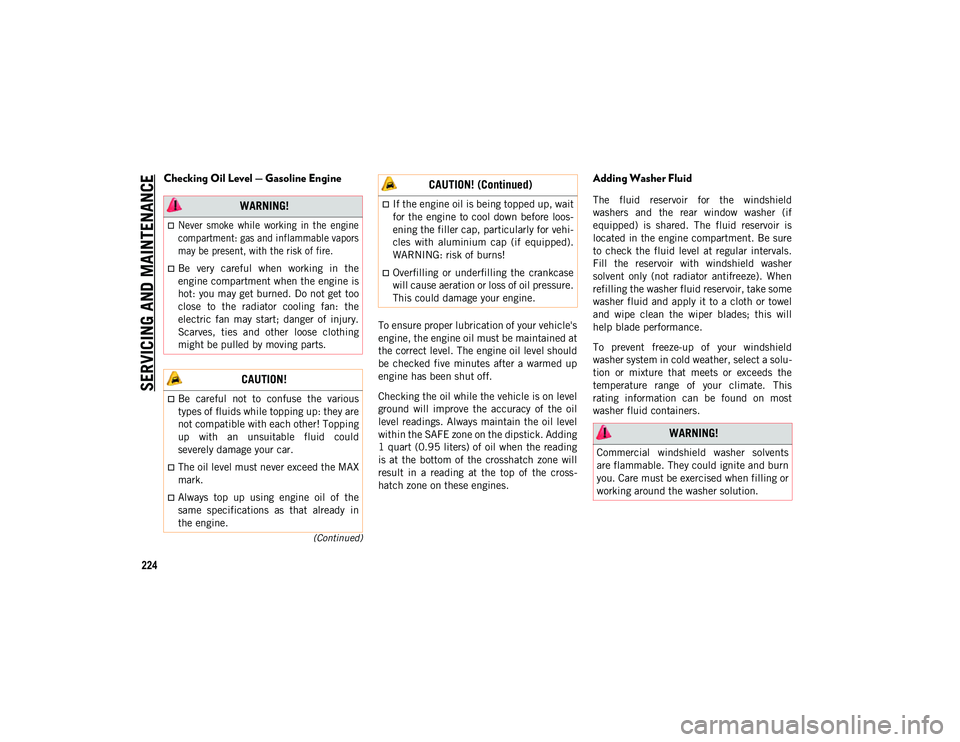
SERVICING AND MAINTENANCE
224
(Continued)
Checking Oil Level — Gasoline Engine
To ensure proper lubrication of your vehicle's
engine, the engine oil must be maintained at
the correct level. The engine oil level should
be checked five minutes after a warmed up
engine has been shut off.
Checking the oil while the vehicle is on level
ground will improve the accuracy of the oil
level readings. Always maintain the oil level
within the SAFE zone on the dipstick. Adding
1 quart (0.95 liters) of oil when the reading
is at the bottom of the crosshatch zone will
result in a reading at the top of the cross-
hatch zone on these engines.
Adding Washer Fluid
The fluid reservoir for the windshield
washers and the rear window washer (if
equipped) is shared. The fluid reservoir is
located in the engine compartment. Be sure
to check the fluid level at regular intervals.
Fill the reservoir with windshield washer
solvent only (not radiator antifreeze). When
refilling the washer fluid reservoir, take some
washer fluid and apply it to a cloth or towel
and wipe clean the wiper blades; this will
help blade performance.
To prevent freeze-up of your windshield
washer system in cold weather, select a solu -
tion or mixture that meets or exceeds the
temperature range of your climate. This
rating information can be found on most
washer fluid containers. WARNING!
Never smoke while working in the engine
compartment: gas and inflammable vapors
may be present, with the risk of fire.
Be very careful when working in the
engine compartment when the engine is
hot: you may get burned. Do not get too
close to the radiator cooling fan: the
electric fan may start; danger of injury.
Scarves, ties and other loose clothing
might be pulled by moving parts.
CAUTION!
Be careful not to confuse the various
types of fluids while topping up: they are
not compatible with each other! Topping
up with an unsuitable fluid could
severely damage your car.
The oil level must never exceed the MAX
mark.
Always top up using engine oil of the
same specifications as that already in
the engine.
If the engine oil is being topped up, wait
for the engine to cool down before loos-
ening the filler cap, particularly for vehi -
cles with aluminium cap (if equipped).
WARNING: risk of burns!
Overfilling or underfilling the crankcase
will cause aeration or loss of oil pressure.
This could damage your engine.
CAUTION! (Continued)
WARNING!
Commercial windshield washer solvents
are flammable. They could ignite and burn
you. Care must be exercised when filling or
working around the washer solution.
2020_JEEP_JL_WRANGLER_UG_RHD_UK.book Page 224
Page 251 of 330
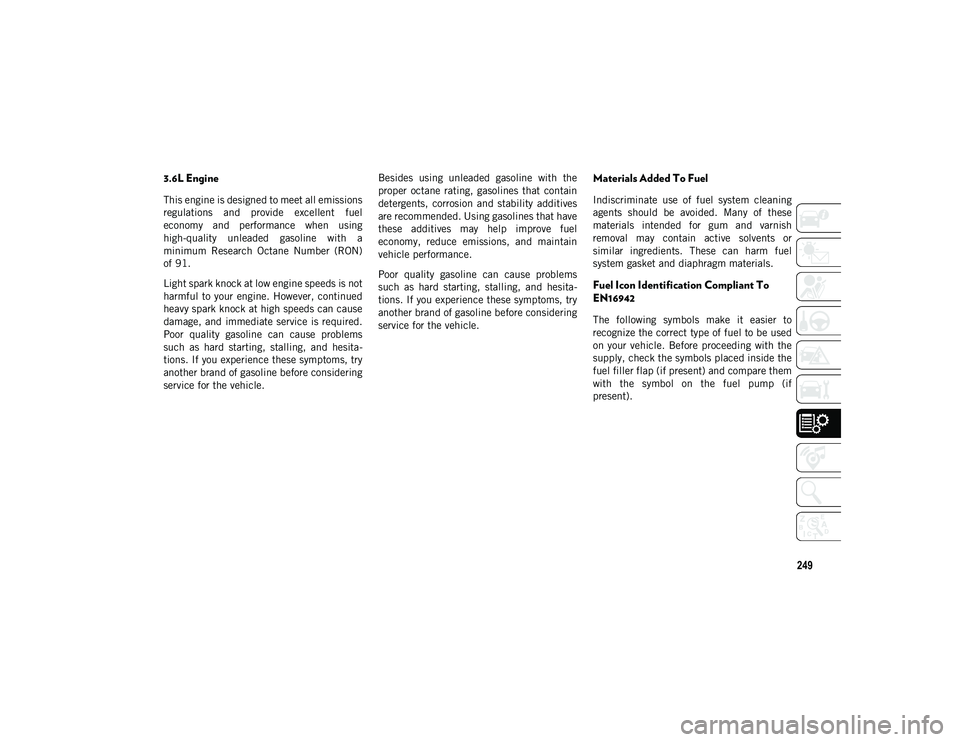
249
3.6L Engine
This engine is designed to meet all emissions
regulations and provide excellent fuel
economy and performance when using
high-quality unleaded gasoline with a
minimum Research Octane Number (RON)
of 91.
Light spark knock at low engine speeds is not
harmful to your engine. However, continued
heavy spark knock at high speeds can cause
damage, and immediate service is required.
Poor quality gasoline can cause problems
such as hard starting, stalling, and hesita-
tions. If you experience these symptoms, try
another brand of gasoline before considering
service for the vehicle. Besides using unleaded gasoline with the
proper octane rating, gasolines that contain
detergents, corrosion and stability additives
are recommended. Using gasolines that have
these additives may help improve fuel
economy, reduce emissions, and maintain
vehicle performance.
Poor quality gasoline can cause problems
such as hard starting, stalling, and hesita
-
tions. If you experience these symptoms, try
another brand of gasoline before considering
service for the vehicle.
Materials Added To Fuel
Indiscriminate use of fuel system cleaning
agents should be avoided. Many of these
materials intended for gum and varnish
removal may contain active solvents or
similar ingredients. These can harm fuel
system gasket and diaphragm materials.
Fuel Icon Identification Compliant To
EN16942
The following symbols make it easier to
recognize the correct type of fuel to be used
on your vehicle. Before proceeding with the
supply, check the symbols placed inside the
fuel filler flap (if present) and compare them
with the symbol on the fuel pump (if
present).
2020_JEEP_JL_WRANGLER_UG_RHD_UK.book Page 249
Page 253 of 330
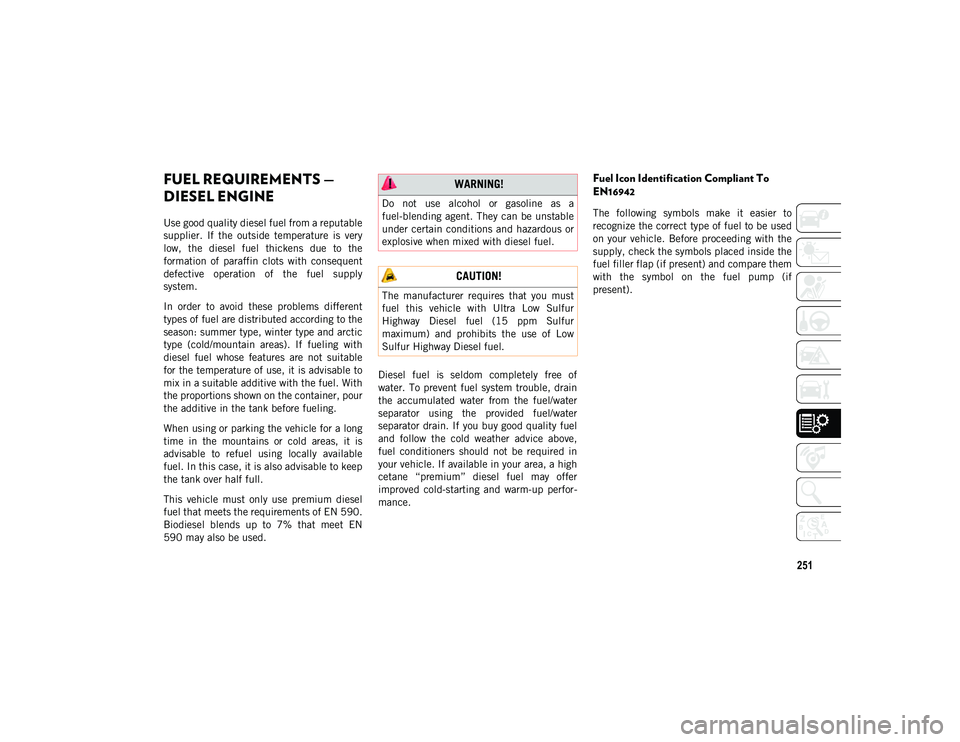
251
FUEL REQUIREMENTS —
DIESEL ENGINE
Use good quality diesel fuel from a reputable
supplier. If the outside temperature is very
low, the diesel fuel thickens due to the
formation of paraffin clots with consequent
defective operation of the fuel supply
system.
In order to avoid these problems different
types of fuel are distributed according to the
season: summer type, winter type and arctic
type (cold/mountain areas). If fueling with
diesel fuel whose features are not suitable
for the temperature of use, it is advisable to
mix in a suitable additive with the fuel. With
the proportions shown on the container, pour
the additive in the tank before fueling.
When using or parking the vehicle for a long
time in the mountains or cold areas, it is
advisable to refuel using locally available
fuel. In this case, it is also advisable to keep
the tank over half full.
This vehicle must only use premium diesel
fuel that meets the requirements of EN 590.
Biodiesel blends up to 7% that meet EN
590 may also be used.Diesel fuel is seldom completely free of
water. To prevent fuel system trouble, drain
the accumulated water from the fuel/water
separator using the provided fuel/water
separator drain. If you buy good quality fuel
and follow the cold weather advice above,
fuel conditioners should not be required in
your vehicle. If available in your area, a high
cetane “premium” diesel fuel may offer
improved cold-starting and warm-up perfor
-
mance.
Fuel Icon Identification Compliant To
EN16942
The following symbols make it easier to
recognize the correct type of fuel to be used
on your vehicle. Before proceeding with the
supply, check the symbols placed inside the
fuel filler flap (if present) and compare them
with the symbol on the fuel pump (if
present).
WARNING!
Do not use alcohol or gasoline as a
fuel-blending agent. They can be unstable
under certain conditions and hazardous or
explosive when mixed with diesel fuel.
CAUTION!
The manufacturer requires that you must
fuel this vehicle with Ultra Low Sulfur
Highway Diesel fuel (15 ppm Sulfur
maximum) and prohibits the use of Low
Sulfur Highway Diesel fuel.
2020_JEEP_JL_WRANGLER_UG_RHD_UK.book Page 251
Page 257 of 330

255
Engine Oil — 2.2L Diesel EngineFor best performance and maximum protection under all types of operating
conditions, the manufacturer recommends SELENIA WR FORWARD engine
oils, or equivalent, SAE 0W-30 ACEA C2 that meet the requirements of FCA
Material Standard 9.55535- DS1 and ACEA C2.
NOTE:
If lubricants compliant with the required specifications are not available,
products that comply with the minimum required characteristics (SAE
grade and ACEA classification) can be used for topping off; in this case
optimal performance of the engine is not guaranteed.
The use of products with specifications other than those indicated above
could cause damage to the engine not covered by the warranty.
Engine Oil Filter We recommend you use Mopar Engine Oil Filter or equivalent.
Spark Plugs We recommend you use Mopar Spark Plugs or equivalent.
Fuel Selection — 2.0L Gasoline Engine Minimum 95 Research Octane Number (RON) (EN228 Specifications)
Fuel Selection — 3.6L Gasoline Engine Minimum 91 Research Octane Number (RON) (EN228 Specifications)
Fuel Selection — 2.2L Diesel Engine Diesel For Motor Vehicles (Specification EN590)
Additive For Diesel Emissions AdBlue® (UREA) AdBlue® (Urea-Water Solution) According To DIN 70 070 and ISO 22241-1
ComponentFluid, Lubricant, or Genuine Part
2020_JEEP_JL_WRANGLER_UG_RHD_UK.book Page 255
Page 281 of 330
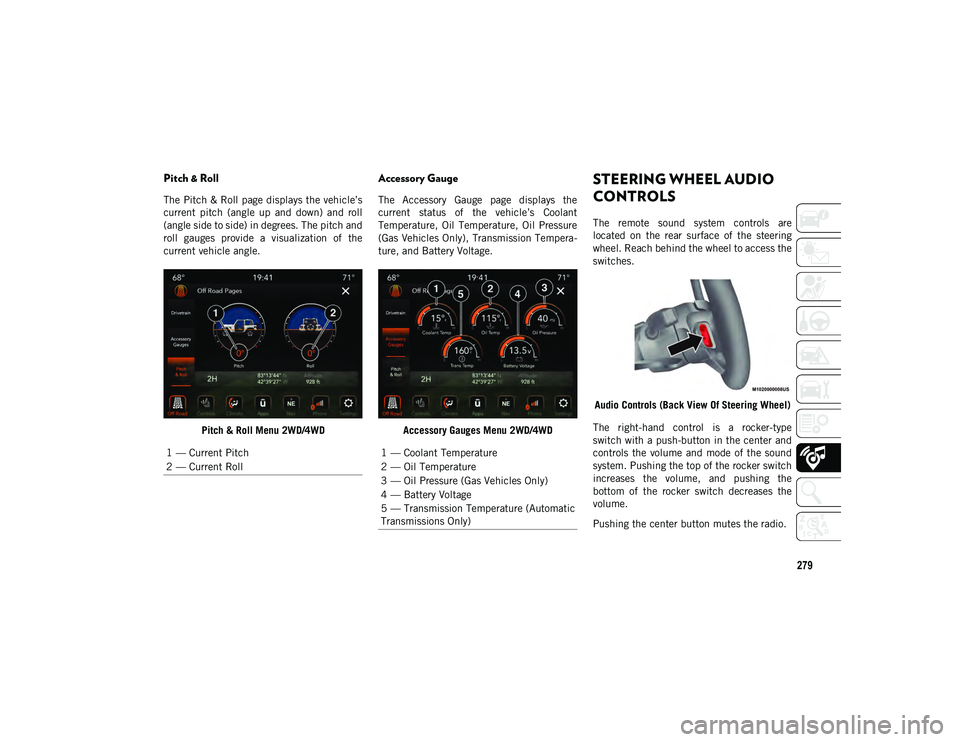
279
Pitch & Roll
The Pitch & Roll page displays the vehicle’s
current pitch (angle up and down) and roll
(angle side to side) in degrees. The pitch and
roll gauges provide a visualization of the
current vehicle angle.Pitch & Roll Menu 2WD/4WD
Accessory Gauge
The Accessory Gauge page displays the
current status of the vehicle’s Coolant
Temperature, Oil Temperature, Oil Pressure
(Gas Vehicles Only), Transmission Tempera -
ture, and Battery Voltage.
Accessory Gauges Menu 2WD/4WD
STEERING WHEEL AUDIO
CONTROLS
The remote sound system controls are
located on the rear surface of the steering
wheel. Reach behind the wheel to access the
switches.Audio Controls (Back View Of Steering Wheel)
The right-hand control is a rocker-type
switch with a push-button in the center and
controls the volume and mode of the sound
system. Pushing the top of the rocker switch
increases the volume, and pushing the
bottom of the rocker switch decreases the
volume.
Pushing the center button mutes the radio.
1 — Current Pitch
2 — Current Roll
1 — Coolant Temperature
2 — Oil Temperature
3 — Oil Pressure (Gas Vehicles Only)
4 — Battery Voltage
5 — Transmission Temperature (Automatic
Transmissions Only)
2020_JEEP_JL_WRANGLER_UG_RHD_UK.book Page 279
Page 326 of 330
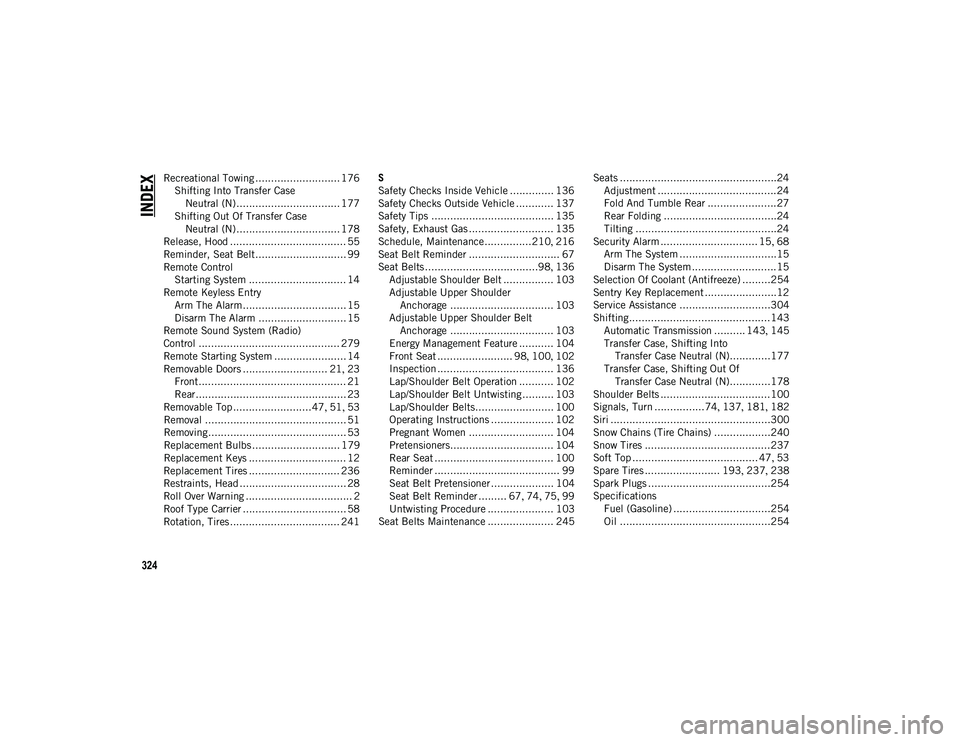
324
INDEX
Recreational Towing ........................... 176Shifting Into Transfer CaseNeutral (N)................................. 177
Shifting Out Of Transfer Case Neutral (N)................................. 178
Release, Hood ..................................... 55
Reminder, Seat Belt............................. 99
Remote Control Starting System ............................... 14
Remote Keyless Entry Arm The Alarm................................. 15
Disarm The Alarm ............................ 15
Remote Sound System (Radio)
Control ............................................. 279
Remote Starting System ....................... 14
Removable Doors ........................... 21 , 23
Front............................................... 21
Rear................................................ 23
Removable Top .........................47 , 51 , 53
Removal ............................................. 51
Removing............................................ 53
Replacement Bulbs ............................ 179
Replacement Keys ............................... 12
Replacement Tires ............................. 236
Restraints, Head .................................. 28
Roll Over Warning .................................. 2
Roof Type Carrier ................................. 58
Rotation, Tires ................................... 241 S
Safety Checks Inside Vehicle .............. 136
Safety Checks Outside Vehicle ............ 137
Safety Tips ....................................... 135
Safety, Exhaust Gas ........................... 135
Schedule, Maintenance...............210
, 216
Seat Belt Reminder ............................. 67
Seat Belts ....................................98 , 136
Adjustable Shoulder Belt ................ 103
Adjustable Upper Shoulder Anchorage ................................. 103
Adjustable Upper Shoulder Belt Anchorage ................................. 103
Energy Management Feature ........... 104
Front Seat ........................ 98 , 100 , 102
Inspection ..................................... 136
Lap/Shoulder Belt Operation ........... 102
Lap/Shoulder Belt Untwisting .......... 103
Lap/Shoulder Belts......................... 100
Operating Instructions .................... 102 Pregnant Women ........................... 104
Pretensioners................................. 104
Rear Seat ...................................... 100
Reminder ........................................ 99
Seat Belt Pretensioner .................... 104Seat Belt Reminder ......... 67 , 74 , 75 , 99
Untwisting Procedure ..................... 103
Seat Belts Maintenance ..................... 245 Seats ..................................................24
Adjustment ......................................24
Fold And Tumble Rear ......................27
Rear Folding ....................................24
Tilting .............................................24
Security Alarm ............................... 15 , 68
Arm The System ...............................15
Disarm The System ...........................15
Selection Of Coolant (Antifreeze) .........254
Sentry Key Replacement .......................12
Service Assistance .............................304
Shifting .............................................143 Automatic Transmission .......... 143 , 145
Transfer Case, Shifting Into Transfer Case Neutral (N).............177
Transfer Case, Shifting Out Of Transfer Case Neutral (N).............178
Shoulder Belts ...................................100
Signals, Turn ................74 , 137 , 181 , 182
Siri ...................................................300
Snow Chains (Tire Chains) ..................240
Snow Tires ........................................237
Soft Top ........................................ 47 , 53
Spare Tires ........................ 193 , 237 , 238
Spark Plugs .......................................254
Specifications Fuel (Gasoline) ...............................254
Oil ................................................254
2020_JEEP_JL_WRANGLER_UG_RHD_UK.book Page 324